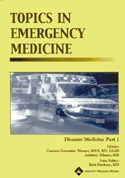

 |
 |
In-Custody Death Syndrome |
 |
 |

CITATION:
Robison D, Hunt S. Sudden in-custody death syndrome.
Top Emerg Med; Jan-March, 2005; Vol. 27, No. 1, pp. 36-43.
(Debra Robison, RN, SANE-A, CEN; Shelby Hunt, MHA, RN, CEN)

CHAS’ REVIEW:
These authors did a hulluva lot of research! So much so, that they might have included “too much” information. Persons other than medical professionals may find it difficult to read all the way through. But, the authors certainly fulfilled their stated purpose for writing it:
This article focused on the definition of SICDS, its clinical manifestations, contributing factors leading to a diagnosis of SICDS, and interventions to be employed when an individual is in custody.
If upper-body holds or prone position restraining are warranted and used by those specifically trained in these techniques, diligent monitoring and observation of these subjects must be done.
The ONLY thing that will prevent restraint asphyxia from occurring is for restrainers to be well-educated about HOW and WHY restraint asphyxia occurs during “upper-body holds or prone position restraining,” or any other form of asphyxial restraint. Funny thing: once people are well-educated about how and why restraint asphyxia occurs, asphyxial forms of restraint (like upper-body holds and prone positioning) are considered to be “warranted” much less often, and are used much less often – if at all.
I especially commend the authors for the following two segments:
When referring to a collection of “73” case histories related to SICD associated with TASER use, the authors reported:
The use of restraint is mentioned only 29 times, but it would certainly make sense that it was used more number of times than the brief histories report.
With a prone restraint, the diaphragm is inhibited and is unable to expand and allow for oxygenation.
Ms. Charly D. Miller
PS: THANK YOU, CAROL! For contributing this article to the Library!

I’ve posted this TOPICS IN EMERGENCY MEDICINE article in PDF file format.
If you don’t have an Adobe Acrobat PDF file program, you can download a FREE version HERE.


 Email Charly at: c-d-miller@neb.rr.com
Email Charly at: c-d-miller@neb.rr.com